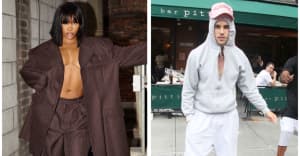Justin Bieber's "What Do You Mean," released in late August and performed for the first time at 2015’s VMAs, is Bieber’s first official single since 2013's "All Around the World." It's also a savvy move—the lyric video has racked 35 million views, those representing just a fraction of the clicks that made the song Bieber’s first official number 1.
This comeback is catchy and low key—just a few sparse piano chords, ticking-clock percussion, and plucked string harmonies frame the simple pan flute hook. Its melody, too, is understated, dancing lightly through the air like a kite caught in a summer breeze. Bieber and co-writer Poo Bear, a longtime collaborator, channel the feeling of anxious infatuation with a delicacy one suspects eludes Bieber in real life—the lyrics When you nod your head yes/ But you want to say no have been criticized for framing women as indecisive. But the song’s lightness very much in his wheelhouse as a performer, thanks to his tone and dexterous vocal control.
“What Do You Mean” is also a move away from the R&B-oriented sound of Journals, Bieber’s 2013 “compilation album” of tracks released weekly from that October to December. At the time, Bieber appeared to be carefully sidestepping a fall-off, using the year to rebuild with a new, more mature approach. Outside of his admittedly massive social media presence, Journals didn’t receive the full promotional push. Videos were made, but there was no “lead single"; eventually, iTunes sales helped many of its tracks chart briefly on Billboard. None of them were certified platinum, as four of his the singles from his 2012 album Believe had been.
With Journals, it seemed Bieber was trying out the blueprint set by Justin Timberlake a decade earlier: building on the success of the popular music of the time to transition from his boy band past into a "legitimate"—adult-facing—pop star. In part, it was a bet-hedging maneuver; released weekly to blogs, this was clearly not work intended to make a huge commercial splash, but to improve his credibility—an attempt to be taken seriously, to show maturation by tackling a genre associated more with serious music listeners than the pop that made his name. The co-executive producer was Rodney "Darkchild" Jerkins, an R&B staple; its collaborators included blog-cool hip-hop stars (Chance the Rapper, Future) and R. Kelly.
That project was less designed to maximize Bieber’s commercial potential than to introduce him to a new audience. Still, the only-modest success of Journals points to significant changes in the music business that have taken place in the years since Timberlake went solo. When that Justin emerged as a solo artist at the beginning of the millennium, R&B and hip-hop were big business. 2003’s pop charts were dominated by black artists—the same artists who were dominating the R&B charts. In other words, Timberlake's move to mature pop star required competing on R&B's terrain, and though his voice may not have had the muscular power of a superstar like Usher, he was able to play to his strengths and succeed within black radio. Bieber is rising in a different time. The internet has reduced the power of black radio—last year, Usher's own "Good Kisser" was a dominant record on R&B radio—but couldn't even crack the top 40 of the Hot 100. (For more on the mechanics behind this change, read Chris Molanphy's detailed article on the subject.)
What this means is that Bieber's new song can perhaps be seen, first and foremost, as a return to the money, following a carefully calculated year of celebrity roasts and image management. It appears that manager Scooter Braun, Bieber, and have been paying close attention to the pop landscape. Their research served them well. ”What Do You Mean” looks internationally, and reflects a new atmosphere for EDM-influenced pop. The best precedent for it may be Major Lazer, DJ Snake, and MØ's "Lean On," a 2015 summer smash which took a more restrained approach than EDM crossover hits of years past, like Zedd’s "Clarity." Bieber’s song also points to the increasing popularity tropical house—in the pop sphere, think of German DJ Felix Jaehn's remix of OMI's "Cheerleader," another surprise dominator of this past summer, or last year's massive Robin Schulz remix of Mr. Probz' "Waves." This sound—see the growing success of Kygo's "Sexual Healing" remix, and in the sun-kissed remixes of hip-hop classics by Norwegian producer Matoma—along with the filter-disco sound Max Martin has produced for artists like The Weeknd, is more likely to fill the pop charts of 2015 and beyond than traditional R&B.
And for now, this tropical style also seems like a better platform to showcase Bieber's talents. Bieber has long had roots in R&B—he entered the industry via Atlanta and mentor Usher, the “teen-crush soul” track “Catching Feelings” was a highlight of his album Believe—but he’s had mixed results working in that space. He’s not a belter but he’s nimble; his singing often works best in situations where he can flutter across a beat. "What Do You Mean" is not a new approach for Bieber, really, but it is a recognition of his strengths.


